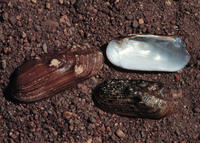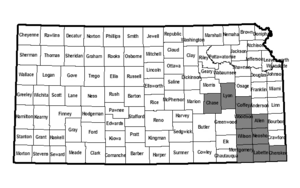RABBITSFOOT MUSSEL

This freshwater mussel is an elongated, rectangular shaped shell, moderately inflated with thick to moderately thick shell. The posterior ridge has longer, distinctive knobs. The exterior of the shell is olive, sometimes yellow-brown and is usually covered with dark green or black triangles. The nacre (inside of shell) is white. The shell can reach a maximum length of 4 inches.
This riverine mussel requires clear streams with gravel substrate and moderate, stable currents. Historically it occurred in the Neosho, Spring and Verdigris Rivers. Currently several known populations occur in the Neosho and Spring Rivers.

Rabbitsfoot Mussels are protected by the Kansas Nongame and Endangered Species Conservation Act and administrative regulations applicable thereto. Any time an eligible project is proposed that will impact the species' preferred habitats within its probable range, the project sponsor must contact the Ecological Services Section, Kansas Department of Wildlife, Parks and Tourism, 512 SE 25th Ave., Pratt, Kansas 67124-8174. Department personnel can then advise the project sponsor on permit requirements.
DESIGNATED CRITICAL HABITATSAs defined by Kansas Administrative Regulations, critical habitats include those areas documented as currently supporting self-sustaining population(s) of any threatened or endangered species of wildlife as well as those areas determined by the Kansas Department of Wildlife, Parks and Tourism to be essential for the conservation of any threatened or endangered species of wildlife.
Currently, the following areas are designated critical for Rabbitsfoot Mussels:
(1) Spring River: from where the Spring River first enters Kansas to the confluence of Center Creek (Cherokee Co.); from the confluence of Center Creek to the backwater of Empire Lake; from Empire Lake dam (Cherokee Co.) to the Kansas-Oklahoma border.
(2) Neosho River: from Iola to Humboldt (Allen Co.); from I-35 to the river's confluence with the Cottonwood River (Lyon County); from John Redmond dam to the Kansas-Oklahoma border.
(3) Cottonwood River: from its confluence with the South Fork of the Cottonwood River (Chase Co.) to its confluence with the Neosho River (Lyon Co.).
(4) Shoal Creek: from the Kansas-Oklahoma border to the backwater of Empire Lake (Cherokee Co.)
(5) Fall River: from the Fredonia city dam to the river's confluence with the Verdigris River (Wilson Co.).
(6) Verdigris River: from K-47 (Wilson Co.) to the Kansas-Oklahoma border.







